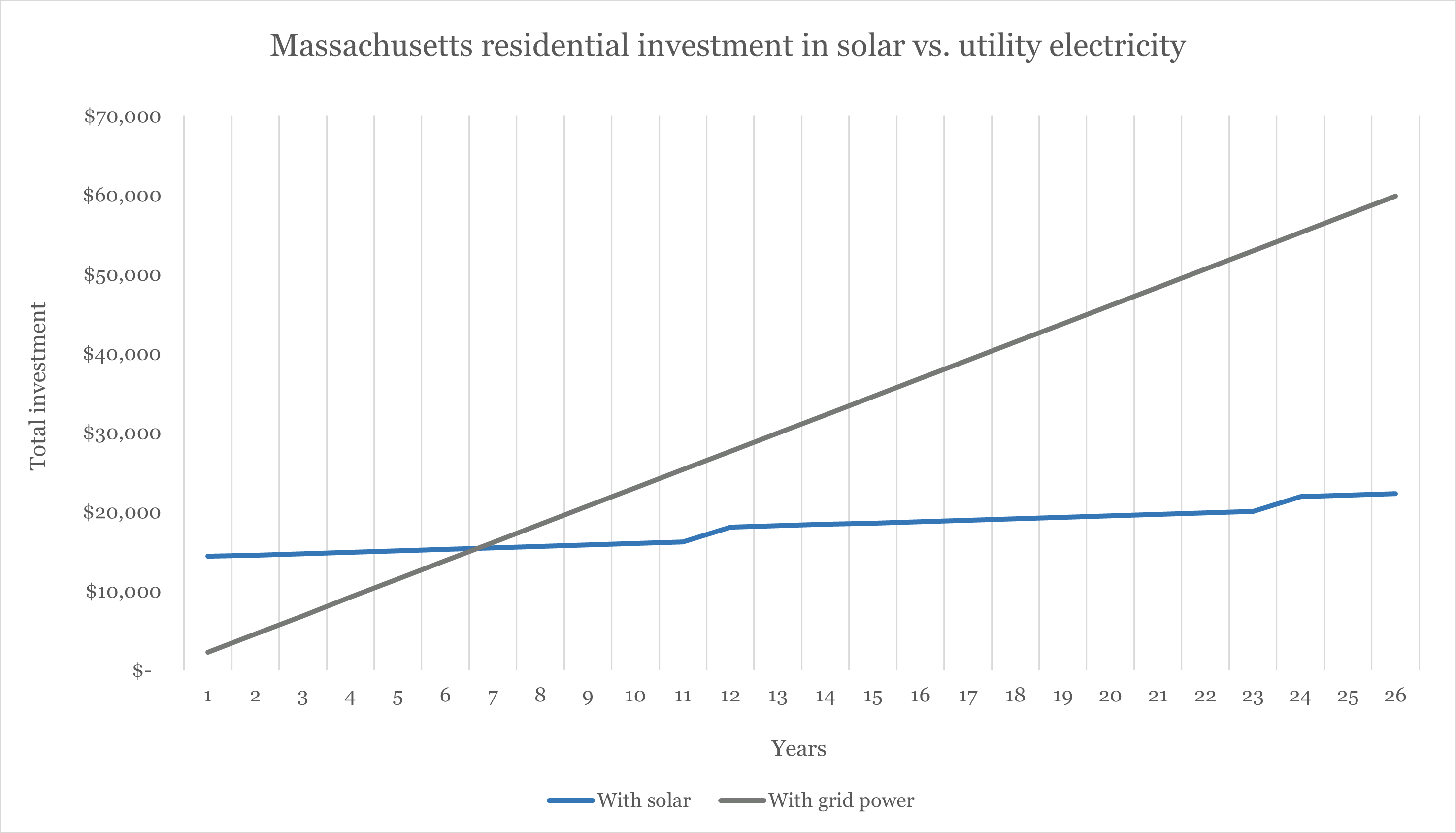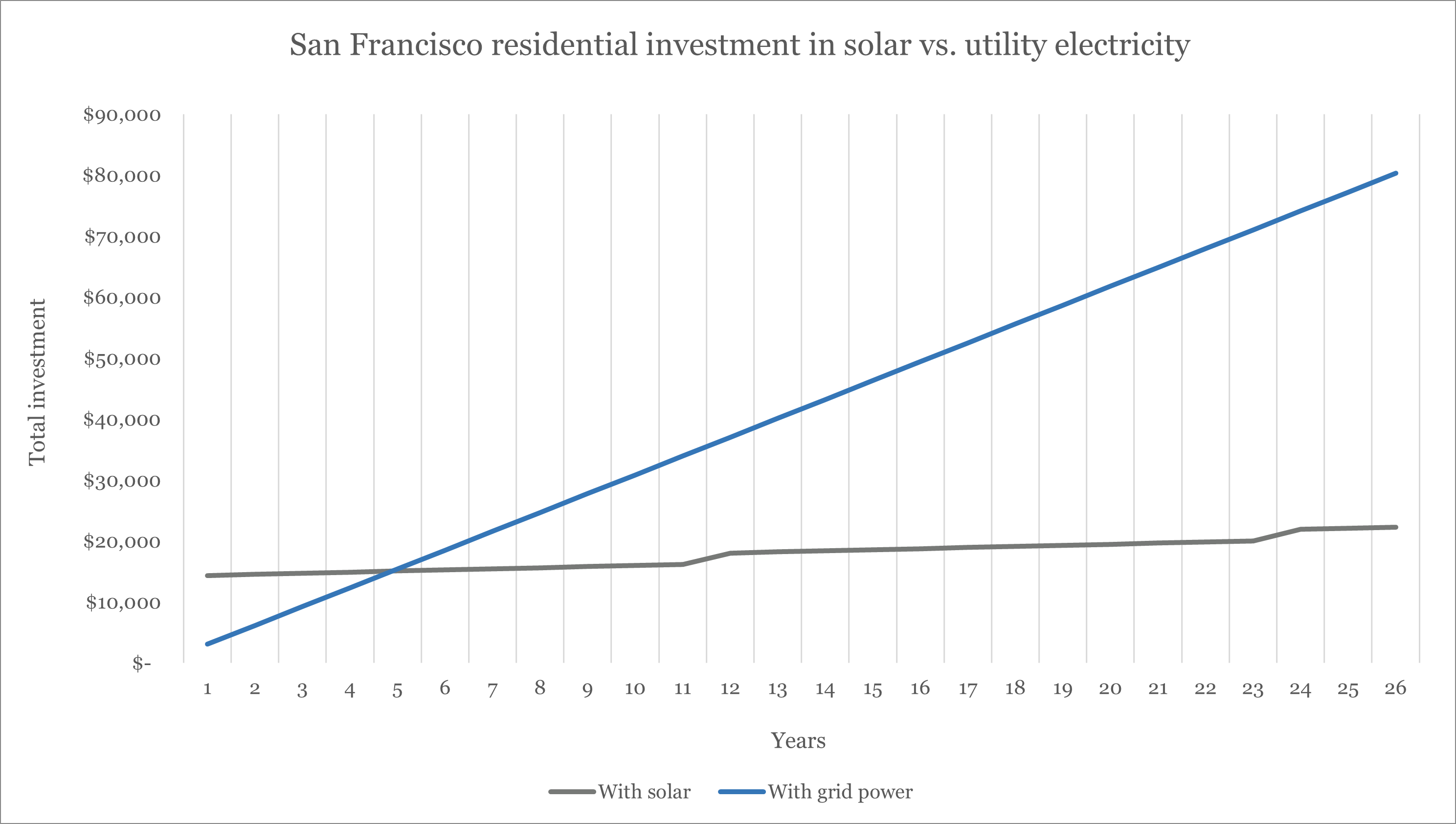A lot of bright ideas are solar-powered: After a colder-than-average winter in 1969, sunlight poured over London at a rate not seen in ten years. Some speculate that George Harrison drew inspiration from that sunny spring to compose Here Comes The Sun.
How will you harness the power of the sun? You may be considering converting this unlimited source of energy into clean electricity for your home, a move that can potentially save you tens of thousands of dollars in the long run.
What follows is a quick look at the economic benefits of powering your home with solar panels.
Solar panels will dramatically reduce the cost of your utility bill as you produce your own electricity. In nearly all cases, this will offset the cost of acquiring and installing residential solar panels after a certain number of years.
The chart below compares the costs of owning home solar panels with the yearly cost of electricity provided by a utility.

Key considerations:
- The cost of going solar was set at $14,200. This includes the cost of a 7.4 kW solar system ($10,784), contractor installation fees ($7,400) and permits ($1,000). A discount of 26%, in line with the federal tax credit (2021), was then applied.
- Hikes in the solar graph at the 12- and 24-year marks reflect the cost of purchasing a new inverter ($1,700), which in our example comes with a 12-year warranty.
- The slight yearly rise in the solar graph is the result of a monthly fee that lets you maintain access to the grid, in this case set at $15.
- The cost of electricity was set at the national average of $0.14 per kWh. While electricity rates rise over time, rate hikes are normally in line with inflation. The household in this example consumes 10,649 kWh per year, the national average.
In this scenario, year 13 is when things get interesting, as that’s when the investment in traditional grid power begins to outweigh the cost of owning and operating solar panels. By year 20, the hypothetical homeowner has saved around $9,400 in electricity costs by switching to solar power.
One of the most alluring aspects of residential solar is the ability to “lock in” a fixed energy rate. Maintenance costs are minimal, so the investment made in the first year represents the bulk of the lifetime cost of solar panel ownership. Meanwhile, utility rates often increase at an unpredictable rate. By playing the long game with solar, your savings will increase exponentially.
US homeowners who pay higher-than-average electricity rates should consider installing residential solar with more urgency. In Massachusetts, for instance, residents pay an average of $0.22 per kWh. At that rate, solar panels may pay for themselves in as little as seven years.
It should be noted that homes in Massachusetts, like most in the northeastern US, are exposed to less sunlight, and more powerful residential solar systems may be needed as a result. But this does not severely impact the return on investment: even a $20,000 investment in solar can be paid off by year nine. Harsh winter weather doesn’t preclude the benefits of residential solar panels either.

Residents in San Francisco pay some of the highest electricity rates in the country at around $0.29 per kWh. This, along with general grid instability and rolling blackouts, may partly explain the logic behind the California Energy Commission’s decision to mandate solar panels on new homes and apartment buildings built in the state.

Because of the high cost of electricity in San Francisco, homeowners there can see returns on their investment in residential solar power in as little as five years. In ten years, solar-powered homes in San Francisco could deliver almost $15,000 in savings. After 20 years, that number increases to over $42,000.
Enjoy more robust savings with net metering
Forty states, along with DC, have set up a system called net metering in which the excess solar energy your panels produce can be sent back to the grid in exchange for credits. This way, when the sun sets and your consumption of grid power increases, you can pay for it using built-up credit. In many cases, utilities also have time-of-use rates in place that make electricity cheaper to consume outside of peak daytime hours, giving solar users a further advantage.
Leasing solar panels is risky
It’s best to own your solar panels to maximize return on investment. Leasing schemes can be structured in a disadvantageous way for consumers. For instance, providers will typically own the solar equipment on your property, meaning they will have the right to claim the federal tax credit in your place. The compounding interest being charged may extend the time it takes to reach a return on investment as well.
The Property Assessed Clean Energy (PACE) loan program running in California, Missouri and Florida has also received negative press lately. These loans cover the cost of energy upgrades and are repaid via property tax increases. They are administered by private companies and pitched by contractors who often fail to adequately explain the complex financial implications of the arrangement. If you decide to take on a loan, take the time to assess all terms and conditions and compare offers from other institutions like banks.
Federal incentives are winding down
The cost of residential solar hardware is dropping dramatically, with module costs having decreased by 89% since 2010 as the industry matures and enjoys economies of scale. Yet the technology remains new enough to maintain government support in the form of incentives. Those who invest in solar now will capitalize on these combined savings. The federal incentives provided a 30% tax credit for installations before 2019. If you install your system before 2022 ends, you stand to save 26%, and the savings drop to 23% in 2023. Federal credits are set to expire in 2024.
Sun, sun, sun, here it comes. The Beatles were onto something. Residential solar is no longer a pipe dream: many homeowners can make the switch, enjoy a decent return on their investment and benefit from clean power without compromise.
Sources:
https://en.wikipedia.org/wiki/Here_Comes_the_Sun
https://unboundsolar.com/solar-information/return-on-solar-investment
https://www.thesolarnerd.com/blog/will-solar-get-cheaper/
https://www.energy.gov/eere/solar/homeowners-guide-federal-tax-credit-solar-photovoltaics
https://www.eia.gov/electricity/monthly/epm_table_grapher.php?t=epmt_5_6_a
https://news.energysage.com/much-solar-panels-save/
https://www.hydroquebec.com/data/documents-donnees/pdf/comparison-electricity-prices.pdf
https://www.bbc.com/news/world-us-canada-44059865
https://ncsolarcen-prod.s3.amazonaws.com/wp-content/uploads/2020/06/DSIRE_Net_Metering_June2020.pdf
https://www.energysage.com/solar/solar-101/net-metering/
https://www.theguardian.com/tv-and-radio/2021/jun/21/john-oliver-last-week-tonight-pace-loans


